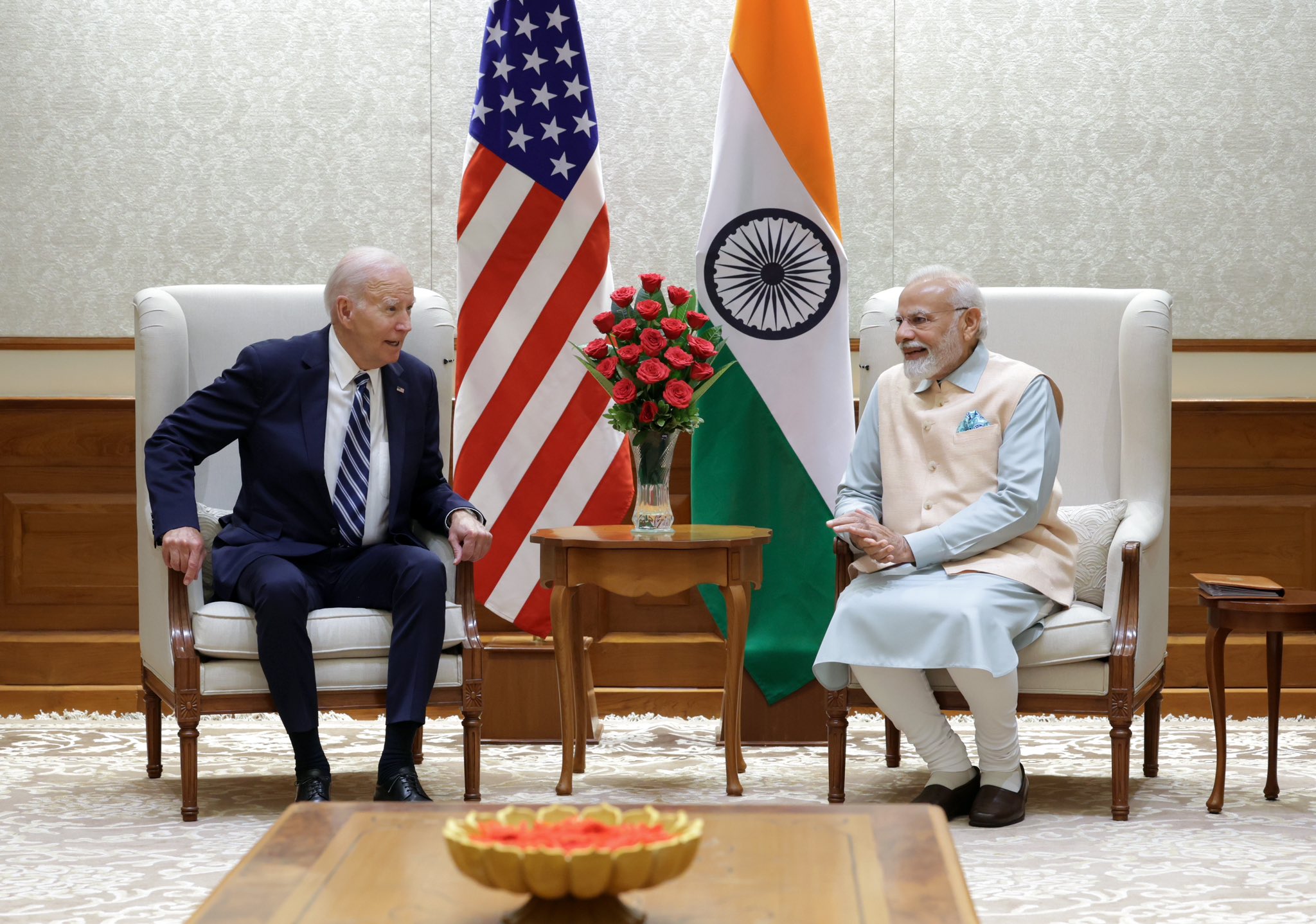US President Joe Biden opened his visit to India on Friday by meeting privately with Prime Minister Narendra Modi at the Indian leader’s home in a session the White House said was marked by “undeniable warmth and confidence” in one another going into the annual Group of 20 summit where climate, economic security and more will dominate the weekend’s talks.
Biden spent 52 minutes with Modi after a lavish welcome ceremony at the airport, and Kurt Campbell, a Biden adviser on the Indo-Pacific, told reporters afterward that warm sentiments have replaced a sense of distrust and uncertainty that previously defined relations between the two countries.
“What I have seen grown over time is an undeniable warmth and confidence between the two leaders,” Campbell said.
Another adviser, Eileen Laubacher, senior director for South Asia at the White House National Security Council, added that Biden and Modi were “so comfortable discussing, really, the breadth of things that we’re trying to accomplish together.”
A joint statement issued after the meeting reaffirmed U.S.-India partnerships on several fronts, especially with regard to computer chips, telecommunications, higher education, access to shipping lanes in the Indo-Pacific and the reduction of carbon emissions that contribute to climate change. Biden also congratulated Modi on India’s recent moon landing.
While India was disappointed that Chinese President Xi Jinping and Russian President Vladimir Putin declined to attend the G20, those absences could give Biden the space to further stitch together U.S. and India ties.
“There are undeniable opportunities here for the United States,” Campbell said. “We fully intend to strengthen and deepen our relationship. We leave it to China, in particular, to discuss and explain why they’re not here.”
Campbell also suggested that a that a major infrastructure and communications project to connect India with the Middle East and Europe will be announced soon.
But when asked if Biden pushed Modi on press access and broader democratic issues in India, Campbell said Biden tries to be clear about issues critical to the health of democracy. Still, Campbell declined to get into specifics, saying the president “has determined that he wants to conduct that dialogue in a dignified, respectful way.”
The U.S. president received a Bollywood-style greeting after Air Force One landed, with dancers in flowing purple outfits gyrating to pop music.
Having feted Modi with a state visit to Washington in June, Biden is banking on the idea that successful diplomacy depends on personal connections. But it’s a relationship largely being explored in private. White House reporters traveling with Biden were denied access to the leaders’ meeting. Indian state media shared visuals of the meeting on social media.
Biden and Modi have had more than a dozen in-person or virtual engagements since 2021 as both look to tighten the U.S.-India partnership amid shared major concerns. Those include an increasingly assertive China and monumental challenges posed by climate change, artificial intelligence, global supply chain resilience and other issues.
Modi has heavily branded the summit as his own. The prime minister has his image posted along the highway from the airport, greeting G20 delegates with quotes about climate change, innovation and India’s unique role as an advocate for developing countries. As a result, Biden was something of a houseguest when he met his Indian counterpart.
Modi held the meeting at his residence, “so it is unusual in that respect,” White House national security adviser Jake Sullivan told reporters Thursday aboard Air Force One.
Biden, a center-left Democrat, and Modi, a conservative Hindu nationalist, are hardly ideological soulmates. Yet, both leaders are increasingly drawn together by China’s military and economic maneuverings in the Indo-Pacific.
India late last month lodged an objection through diplomatic channels with Beijing over China’s new standard map that lays claim to India’s territory along their shared border.
The version of the Chinese map published by the Ministry of Natural Resources website shows Arunachal Pradesh and the Doklam Plateau — over which the two sides have feuded — included within Chinese borders, along with Aksai Chin in the western section that China controls but India still claims. The Philippines and Malaysia have also lodged protests over the new Chinese map.
The map was released just days after Modi and Jinping met on the sidelines of a summit of the BRICS bloc of developing economies — Brazil, Russia, India, China and South Africa — and agreed to work to de-escalate tensions at their disputed border.
The administration was eager to build on the momentum from Modi’s June state visit, which included announcements on climate, health care and space as well as some major private sector projects.
The two sides set the groundwork for U.S.-based General Electric to partner with India-based Hindustan Aeronautics to produce jet engines for Indian aircraft in India and the sale of U.S.-made armed MQ-9B SeaGuardian drones. U.S.-based Micron Technology agreed to build a $2.75 billion semiconductor assembly and test facility in India, with Micron spending more than $800 million and India financing the rest. The administration also plans to discuss civil nuclear issues.
The White House has sought to play down Biden and Modi ‘s differences over Russia’s war in Ukraine. India abstained from voting on U.N. resolutions condemning Russia and refused to join the global coalition against Russia. Since the start of the war, the Modi government has dramatically increased its purchase of Russian oil.
Biden’s effort to pull India closer has been shadowed by concerns from activists and some American lawmakers about India’s human rights record under Modi.
The prime minister has faced criticism over legislation amending the country’s citizenship law that fast-tracks naturalization for some migrants but excludes Muslims, over a rise in violence against Muslims and other religious minorities by Hindu nationalists, and the recent conviction of India’s top opposition leader, Rahul Gandhi, for mocking Modi’s surname.
India also ranks 161st out of 180 countries in this year’s Press Freedom Index published by Reporters Without Borders.

